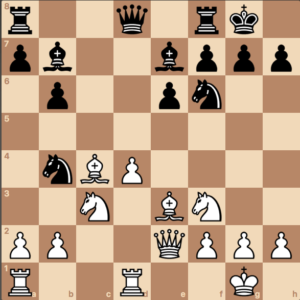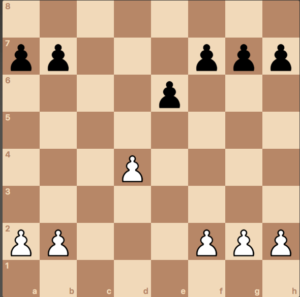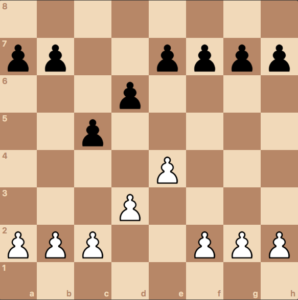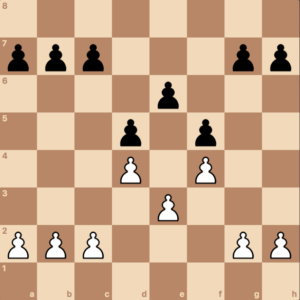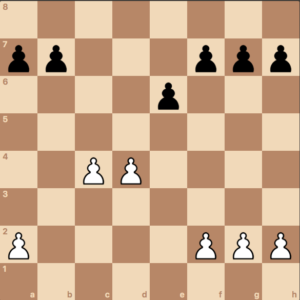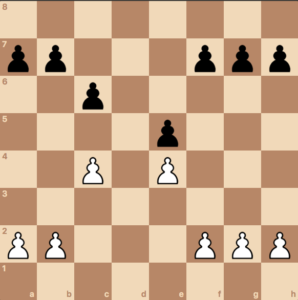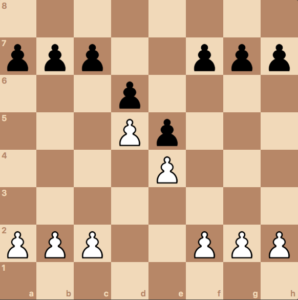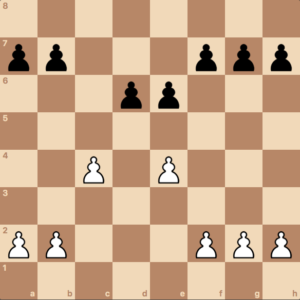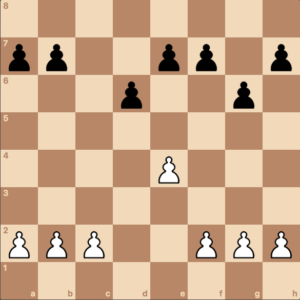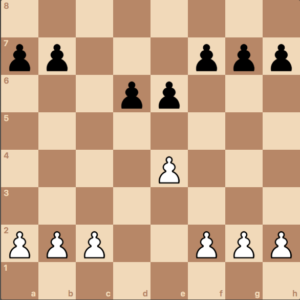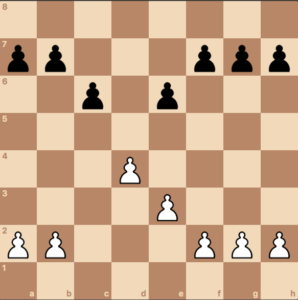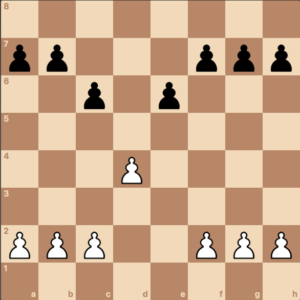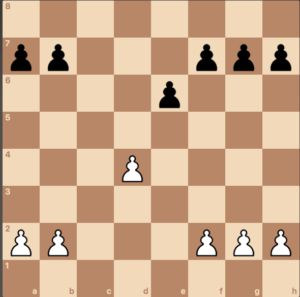In the diagram below, what move should White make?
Take a few moments to think about it.
…
Okay.
Time is up.
If your mind immediately jumped into trying to find some tactic white should play, then you are out of luck.
There is no special tactic here.
This is a position, like most positions you will see in chess, where there are no immediate tactics to take advantage of.
In situations where there are no tactics involved, what do you do?
How do you evaluate this position and see the essence of it?
Perhaps you are an advanced club player and noticed that white and black both had an open c-file or that both white and black both have their bishop pairs, but didn’t know how to formulate this knowledge into a plan.
Perhaps you had no idea what to play here.
Either situation is okay.
This is a position, like many others, that 99% of chess players have no idea how to evaluate correctly.
In this article, we will show you the correct mental framework to evaluate not only this position but a whole family of positions that have the same theme as this position.
We will then broaden our framework so that you will be able to correctly group the majority of positions you see in a chess game into different themes so that you always know the right thing to do all ways.
The solution. Asking yourself the right questions
What is the best move?
Asking yourself what “the best move” in this position is probably the wrong question.
The reason why is that even though you are searching for the best move, trying to ask yourself that will most likely make you think and focus on the wrong things.
Is the best move a tactic? A waiting move? Or some positional move?
What are the imbalances in this position?
A better question to ask yourself would be, “What are the imbalances in this position”.
Imbalances in chess were defined by IM Jeremy Silman in this book “Reassess your chess”. Imbalances are fundamental differences that exist between your position and your opponent’s position.
- Superior Minor Piece.
- Pawn Structure. Doubled. Isolated. Backward. Passed.
- Space.
- Material.
- Control of key lines and squares.
- Development.
- Initiative.
If you ask yourself this question, you will site things such as the isolated d pawn on the queen file, the open c file for both white and black, or the backward pawn at a7.
This helps, but as a player, you have no idea which one of these imbalances is more important to focus on and develop a plan around.
Should you focus on trying to control the c file, push your d pawn or try to push the knight away with a3?
The problem with just looking at imbalances in a given chess position is that you can’t see the forest for the trees.
You have a list of imbalances but have no idea what imbalance to focus on.
Figuring out the best move to make is difficult because you don’t know which imbalance to focus on.
Let’s try to fix this by asking another question instead.
What Pawn Structure does this position have?
The pawn structure of a given chess position is what the position would look like if you removed all pieces from the board and just kept the pawns.
Let’s go ahead and do this.
If you had some background in pawn structures, you would realize that this pawn structure is called the Isolani and comes primarily from the Queen’s Gambit opening.
You would also know by studying the Isolani pawn structure that whenever you see it, the following statements are true.
- The Isolani is a weakness in the endgame for white because the d4 can be blockaded from becoming a passed pawn by placing a piece on d5.
- The Isolani is a weapon of attack in the middlegame. Specifically, White’s goal is to place a Knight on e5 an outpost square to try and make an attack on the Kingside.
Given this information from just the pawn structure alone, we can figure out the plans for Black and white.
Black should be trying to trade pieces and lead to a favorable endgame, as well as trying to blockade the d5 square.
White should be trying to avoid trading pieces, and make an attack in the middlegame.
You can use this type of thinking to find the right move for a lot of different chess positions.
So it turns out there are about 15-30 different pawn structure families, that if you study, should encompass the majority of positions you see while playing chess.
To become a great chess player, you should
- be able to see any chess position
- recognize what pawn structure family the position belongs to
- from the pawn structure, you should know what the best plans for white and black are.
Chess masters are able to do the following subconsciously, whether they realize it or not.
What Pawn Structures Do I Need To Learn?
Below I’ve summarized every pawn structure that you need to learn.
If you click on any of the chess diagrams below, you will be linked out to an article that explains the key ideas in that pawn structure in-depth (coming soon).
The Closed Sicilian
The Stonewall
Queen’s Gambit – Hanging Pawn Formation
Kings Indian — Rauzer Formation
Closed d5 Chain
Hedgehog Formation
Sicilian Dragon
Sicilian – Scheveningen
Slav Formation
Caro Pawn Structure
The Isolani Pawn Structure
If you want to become good at chess, you must learn about chess Pawn Structures.
A lot of chess strategy comes down to how the pawns are placed on the board. Their configuration, mainly determines what you should be doing as your next move.
If you are serious about improving your chess, then you must learn about chess pawn structures.
Okay, now I know that pawn structures in chess are important.
Where do I go to learn about pawn structures?
Hopefully, I was able to show you the importance of pawn structures in chess in this article.
Now, this begs the question, where should I go to learn pawn structures?
For a general overview, you can go to Wikipedia here.
This wiki acts as a quick cheat sheet.
If you already learned the main ideas for different pawn structures, why they are important and how to use the different concepts, but it’s foggy in your head, then this wiki will just help jog your memory.
For a more in-depth look, you can buy ‘Pawn Structure Chess’ from Andrew Soltis here.
This book is pretty much the chess communities standard for Pawn Structure knowledge and is something that belongs in every Chess Players library.
The one caveat I would say is that this book is that it is way over the head of most chess players.
You can tell it was written by a Grandmaster (since it’s unnecessarily verbose and doesn’t get to the point).
I treat this book more as a reference.
If I want really specific details of a specific game with a pawn structure to see how a certain idea was executed, then I use this book for that.
Not really anything else.
The other resource you can use is that you can buy a diamond membership at chess.com and watch their ‘Pawn Structure 101’ series.
The first video in the series, I linked above, is free, but I believe you have to pay for the rest of them.
This video series is one of the best resources I’ve found to learn about pawn structures.
As the comments in that video say, however. there is a lot of digression in the video series. The video series go so fast, that it detracts from the point: learning about pawn structures.
So given the lack of really excellent resources that teach chess pawn structure, I went ahead and decided to create it myself.
In this site, I will be creating articles that cover every main pawn structure.
The goal here is to make the most comprehensive and clear resource ever created on pawn structures in chess.
We will cover everything that you need to know.
These articles are coming soon.
-Simplifychess.com
